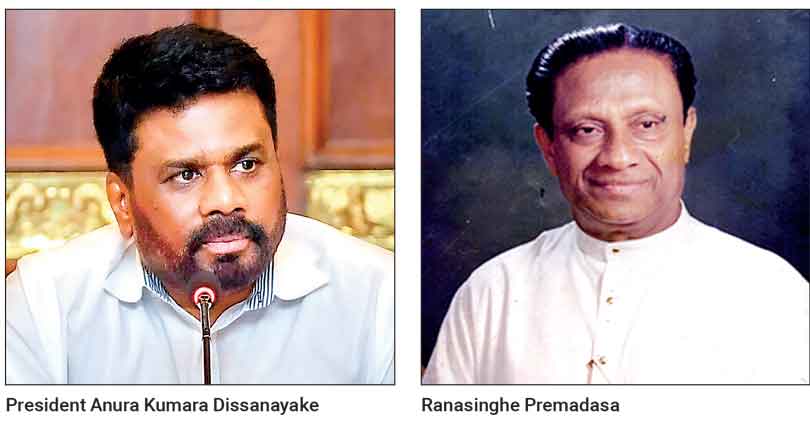Tuesday Apr 08, 2025
Tuesday Apr 08, 2025
Tuesday, 12 November 2024 01:17 - - {{hitsCtrl.values.hits}}

It was not reported that any of the agencies present at the meeting with the President held on the 14th has commented or qualified the President’s emphasis for a specific sustainable program. This does not mean that nothing has happened in the past or no institutional and regulatory arrangements are in place. Sri Lanka is abundant in the solutions and technologies and legal and institutional network required addressing disaster management
 Late President Premadasa
Late President Premadasa
I have worked with all the Executive Presidents except President Gotabaya Rajapaksa (I have no idea whether it was his luck or mine) in different capacities during my tenure in the public service and even afterwards. The way they managed or rather mis-managed the economy was different from one to the other. Late President Ranasinghe Premadasa’s management style was unique, flawless and foolproof. He monitored and followed up each and every decision he made.
We used to keep a piece of paper and a pencil beside our landline telephone. Mobile phones were just entering into the market. Any moment from 4 in the morning the phone can ring. We snatch the paper and the pencil. The President directs to attend to a particular matter. By 10 in the morning a second call comes inquiring about the progress.
With this system of monitoring and follow up he was able to establish 200 garment factories in the rural countryside, implement the first ever Government sponsored Poverty Alleviation Program, Janasaviya, One million Housing Program, Gamudawa Program and Rural road rehabilitation program within a period as short as four years.
On 2 May 1993, when I was doing my usual morning walk, I met two Ministry Secretaries. Both have greeted me with “Chandre, What a sigh of relief”. That was the day after the assassination of the late President Premadasa.
I wrote this little anecdote to emphasise the importance of monitoring and following up on decisions made.
President Anura Kumara
During a period as short as six weeks, President AKD has held meetings with all key Ministries and several other organisations and outlined his Government’s plans and expectations. He gave directives related to Agriculture, Education, Power and Energy, Rural Development, Public Service, Exports, Tourism, Industry, Business and Enterprises. The President has underscored the urgency of accelerating and swift implementation of development projects. My intention is to examine how much these decisions have been followed up and translated into action. Considering the limitation of space, I decided to select one area to illustrate this i.e. devastating flood and the havoc it brought a few days back.
Meeting to discuss the flood situation
On 14 October, the President held a meeting with officials to discuss the flood situation and the measures to be taken. The meeting was attended by the Secretaries to the President and Ministries of Finance, Defence and Disaster Management, Directors General of Disaster Management Division, Disaster Management Centre, National Building Research Organization and Meteorological Department and Senior Assistant Secretary of the National Disaster Relief Service Centre.
The President has emphasised, at this meeting, the need for a specific and sustainable program to address the recurring flood situation in the country. He noted that frequent flooding requires long-term solutions for effective control.
Since then three weeks have elapsed; rain seized; flood victims are returning their homes; no news on the emphasis on specific and sustainable program. May be it has to be reemphasised when the next disaster struck. Until then there is no urgency.
Why a specific sustainable program is important?
Sri Lanka is a blessed island surrounded by Indian Ocean water but, is punished by water – lack of it as well as abundance of it. “Water is a gift of nature and its management is man’s (of course woman’s as well) responsibility”.
The recent floods, landslides and the inclement weather brought havoc. Occurrence of heavy rainfall, floods and long droughts increased significantly over the recent years. Sri Lanka is being positioned among the top ten countries at risk of extreme weather events by the Global Climate Risk Index. Floods are common and widespread among the most frequent weather-related disasters in Sri Lanka. Popular and common belief that disasters are natural is misleading. Change of the weather is natural. But the disaster occurs when the weather changes intersects with human activities.
The United Nations Office for Disaster Risk Reduction (UNDRR) emphasises that human actions such as deforestation, urbanisation and inadequate infrastructure worsen the impacts of events like floods, earthquakes and storms. Building in flood-prone areas and settling communities close to rivers and on mountain slopes increases the vulnerability to floods, transforming into a devastating disaster. Inadequate building norms, Marginalisation of people and poor choices on Land-use planning make natural disasters worse. Change of weather is a given but the disaster that follows can be avoided.
‘Climate Change’ has come to the top of the Agenda on international platforms. Human Activity is the Cause of Increased Greenhouse Gas Concentrations. Over the last century, burning of fossil fuels like coal and oil (Sri Lanka is notorious for this) has increased the concentration of atmospheric carbon dioxide (CO2). Taken together, these miserable and sometimes deadly effects are what have come to be known as climate change. Human activity is the primary driver.
World Bank 2018, South Asia’s Hotspots: The Impact of Temperature and Precipitation Changes on Living Standards. South Asia Development Matters has estimated that 87 % of Sri Lanka’s population lives in moderate or severe hotspots for disasters. Nearly half of Sri Lanka’s population lacks disaster preparedness, a key vulnerability factor aggravated by accelerating climate risks.
All the above findings point to the fact that disasters are not free from human intervention. Then disaster management arguably requires human intervention too. We human beings that include the agencies responsible for disaster handling need to prepare a specific and sustainable program to address the recurring disasters and to minimise the damage caused by them.
Are we to start from the scratch?
It was not reported that any of the agencies present at the meeting with the President held on the 14th has commented or qualified the President’s emphasis for a specific sustainable program. This does not mean that nothing has happened in the past or no institutional and regulatory arrangements are in place. Sri Lanka is abundant in the solutions and technologies and legal and institutional network required addressing disaster management.
The Government introduced the Sri Lanka Disaster Management Act in 2005. The Act provides the legal foundation and strategic directions and proposes an institutional structure and coordination mechanism from national to local levels. A National Council for Disaster Management (NCDM), a high-level inter-ministerial body chaired by the President and a Disaster Management Centre (DMC) was established. Subsequently a separate Ministry for Disaster Management was established.
The National Disaster Management Policy 2013, National Disaster Management Plan (NDMC) 2013- 2017, and National Emergency Operation Plan (NEOP) 2017 have been developed in accordance with the SLDM Act. Several other policies and plans, such as National Climate Change Adaptation Policy and the Plan, Water Conservation policy, Local Government Policy, Flood Protection Ordinance, National Land Use Policy, National Physical Plan and Policy and several sector specific policies also contribute to Disaster Risk Management (DRM) in the country.
Integrated Water Resources Development: The Way Forward for Sri Lanka to tackle the Climate Crisis-UNDP 04 October 2023 suggests “In moving forward, Sri Lanka requires a two-track approach. First is to invest in our infrastructure. As this requires more funding and time, in parallel, integrated water resource management should be promoted, tapping into Sri Lanka’s 4,000-year-old cascade systems.”
How, who, when would the program be prepared
The question is how, who and when would prepare the program envisaged by the President, follow it up and monitor the progress?
There is already a National Disaster Management Plan (NDMP) for 2022-2030 prepared in 2022 running into over 200 pages with 8 Chapters, 17 Annexures and 13 Figures. This plan guides all ministries, departments, statutory bodies, officials of sub-national administrations (provincial ministries and district divisional and local government); relevant officers and personnel from Governmental and UN Agencies, INGOs Non-Governmental organisations; civil-society organisations, private sector, and professional organisations in Sri Lanka.
NDMP would throw a lot of lights in preparation of the program envisaged by the President. Only drawback is “The NDMP aims to set the 2030 strategic direction for Disaster Risk Management in the country, in line with the national development vision of the Government, “Vistas of Prosperity and Splendor”.
A senior officer once told me “Chandre, when you prepare a report don’t worry too much about the content. But, make sure you have the picture of the President or the Minister on the front cover”. Following that saner advice one can replace “Vistas of Prosperity and Splendor” with “A Rich Country-A Beautiful Life”.
There are two other plans (perhaps more) already prepared. One is the ‘National Drought Plan for Sri Lanka’ by the Ministry of Environment in September 2020; the other is National Emergency Operation Plan (NEOP) formulated by Disaster Management Centre in 2017.
Way forward
The President has made decisions; issued directives; plans, policies, agencies, legal and administrative arrangements are in place. I believe that someone with command and clout will organise an inter/multi disciplinary/agency committee a). To peruse all relevant documents, reports and plans already in place; b). To set a time target and c). To assign the responsibilities to identified agencies/personnel. The Committee would meet from time to time and monitor the progress and provide assistance and instructions to resolve issues that arise during the implementation stage and follow up.
Sri Lanka has rich experience in such arrangements. I remember Secretaries such as Paskaralingam, Dr. Wickarma Weerasooria who were known as super secretaries have revived “Secretaries Committee’ to monitor the progress of directives and decisions made and follow up by resolving issues that arose in implementation. Dr. Lloyd Fernando as the DG National Planning facilitated and serviced the Committee. Dharmasiri Peiris a luminary in the public service, as the Secretary Ministry of Agriculture established a Committee consisting of players at both the centre and the Provincial level to ensure the Agriculture value chain is working smoothly. Palihakkara the most illustrious Foreign Affairs Secretary established an inter-ministerial Committee to follow up the developments in all the Ministries for the benefit of Sri Lankan Missions abroad as well as the respective Ministries.
These hands on experience and the experiments would be useful in establishing a mechanism for monitoring and follow up of directives and decisions made by the President.
Monitoring and follow-ups provide concrete evidence of outcomes.
(The writer is former Secretary to the Ministry of Plan Implementation. He can be reached on [email protected].)